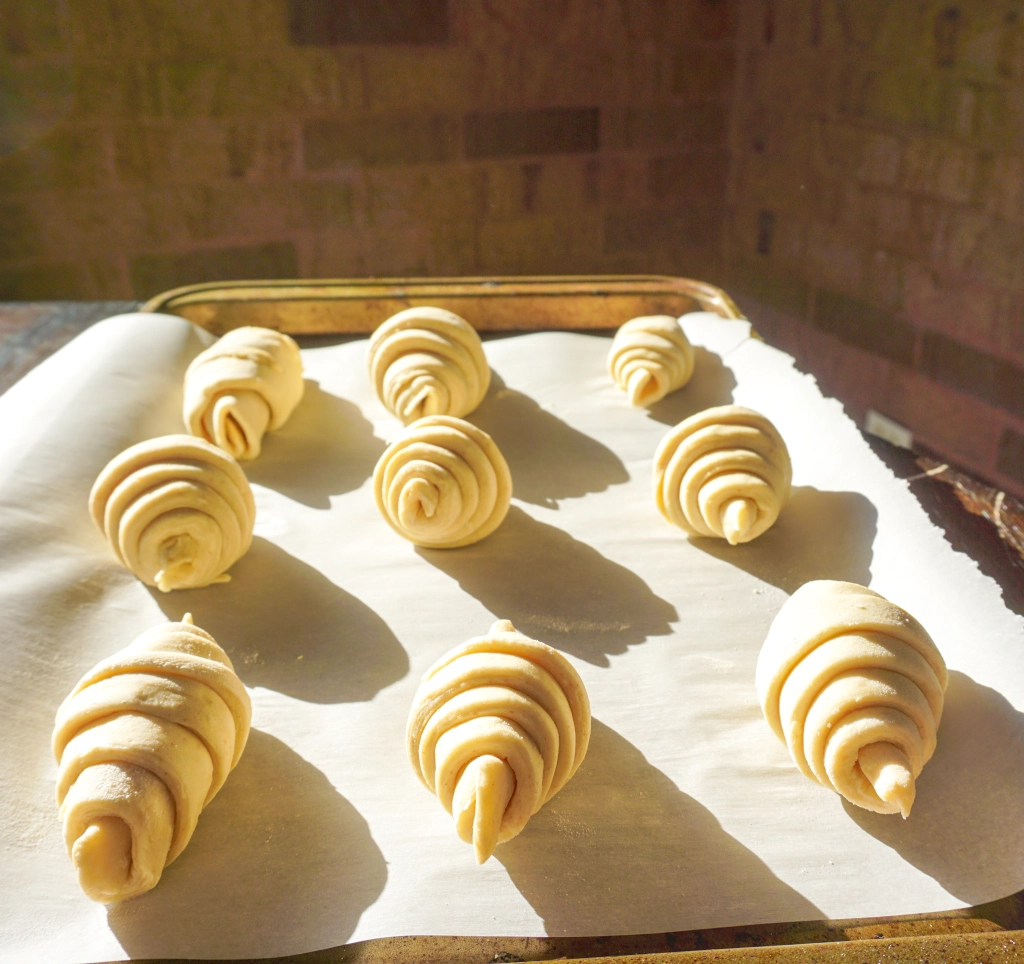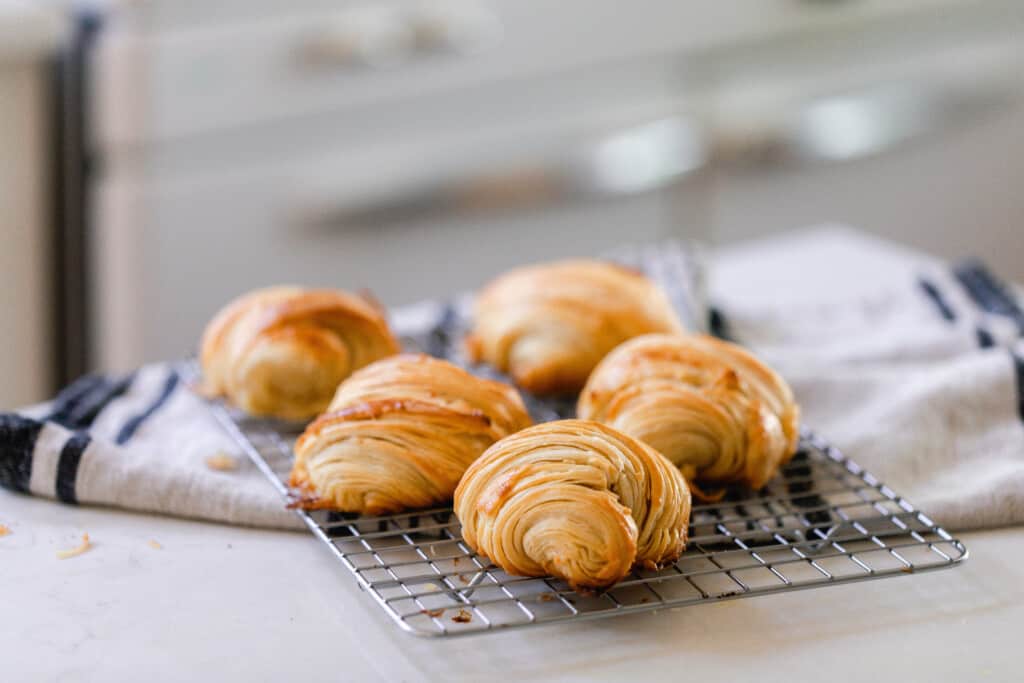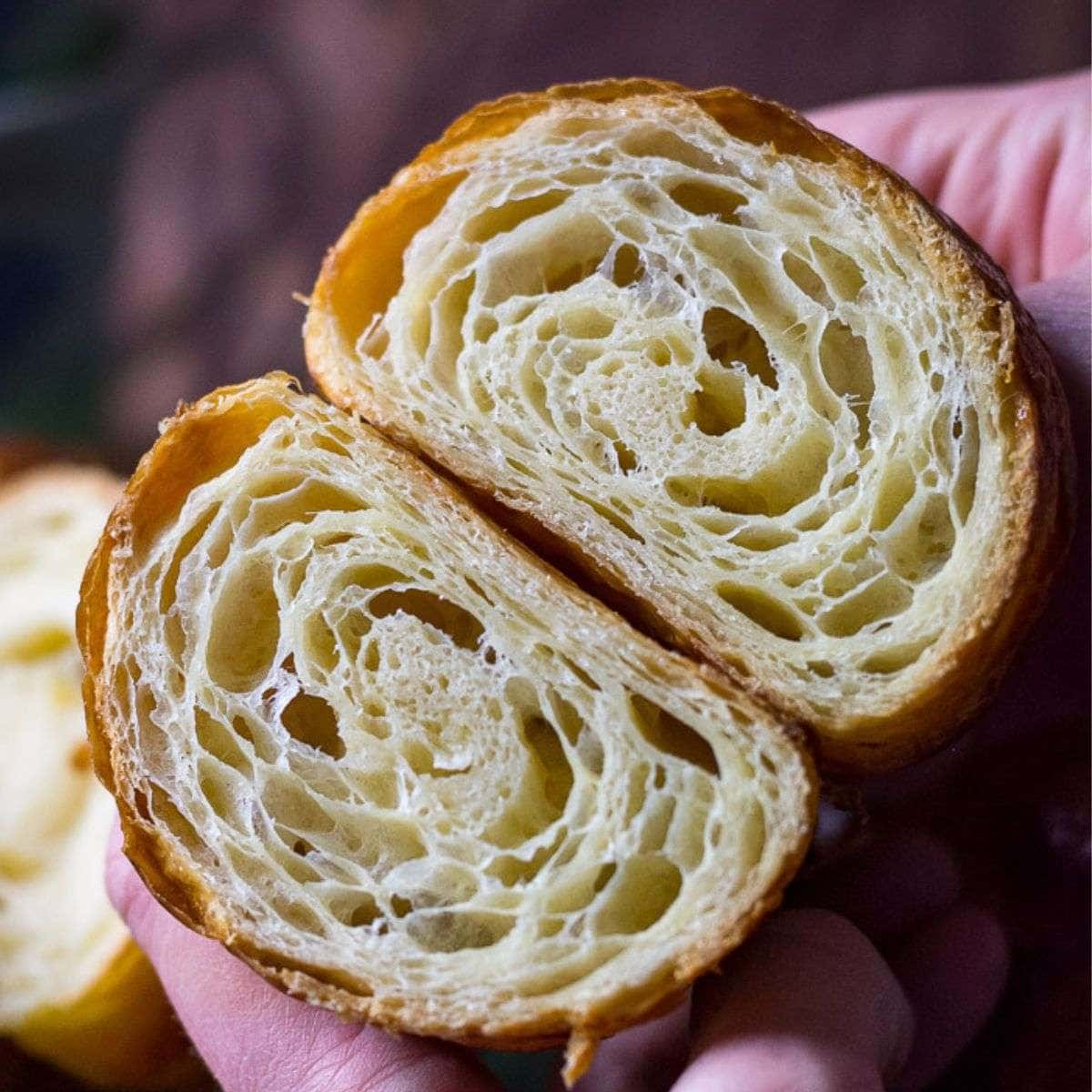Sourdough croissants blend the intricate craftsmanship of traditional French baking with the tangy depth of sourdough fermentation, creating a delightful twist on the classic croissant. Unlike their conventional counterparts, which rely on commercial yeast for leavening, sourdough croissants use a natural starter. This starter imparts a slightly sour flavor that contrasts beautifully with the buttery richness typical of croissants.

The process of making sourdough croissants is both an art and a science. It begins with a well-matured sourdough starter, which is mixed into a dough containing flour, water, sugar, and butter. Layers of dough are meticulously folded with additional butter through a technique known as “laminating.” This labor-intensive step is crucial as it creates the thin, delicate layers that puff up into flaky tiers when baked.
The fermentation process in sourdough croissants is slower compared to yeast-leavened pastries, often extending over several days. This slow fermentation allows for the development of a more complex flavor profile and a pleasingly chewy texture that makes these croissants a gourmet treat. Each bite offers a subtle sour note that enhances the melt-in-your-mouth buttery experience, making sourdough croissants a unique and irresistible indulgence.
Kitchen Tools Needed
Ingredients for Sourdough Croissants

Difference Between Croissants And Crescent Rolls?
Croissants and crescent rolls might look similar with their iconic curved shape, but they differ significantly in texture, flavor, and preparation. Croissants originate from French cuisine and are made with a yeast-leavened dough that’s laboriously laminated with butter. This process creates thin, delicate layers that bake into a flaky, airy, and butter-rich pastry.
In contrast, crescent rolls, often found in American kitchens, are typically made from a softer, quicker dough that isn’t laminated but simply rolled and shaped. They’re more bread-like, less flaky, and generally sweeter than croissants. Crescent rolls also commonly come in pre-made, easy-to-bake preparations, making them a convenient, though less refined, alternative to the traditional croissant.
How To Make Sourdough Croissants?
Preparing the Dough
Start by mixing the active sourdough starter with lukewarm water and milk in a large mixing bowl to dissolve. Add the flour, sugar, melted butter, and salt. Mix until a rough dough forms. If using a stand mixer, use the dough hook attachment and mix on low for about 5 minutes. If kneading by hand, turn the dough onto a floured surface and knead for about 10 minutes until smooth and elastic. Cover the bowl with a damp cloth and let the dough rest at room temperature for about 2 to 3 hours until slightly puffy but not doubled in size.
Laminating the Dough
While the dough is resting, prepare the butter block for laminating. Place the cold butter between two sheets of parchment paper and pound with a rolling pin to form a square about 1 cm thick. Refrigerate until ready to use. Once the dough has rested, turn it out onto a lightly floured surface and roll into a rectangle large enough to encase the butter block. Place the butter block on half of the dough and fold the other half over it, sealing the edges to encase the butter completely. Roll out the dough into a long rectangle, then fold it into thirds like a letter. Wrap in plastic wrap and chill in the refrigerator for 1 hour.

The Folding Process
Remove the dough from the refrigerator and repeat the rolling and folding process two more times, chilling the dough for 1 hour between each fold. This builds the layers that will give the croissants their flaky texture.
Shaping the Croissants
After the final chill, roll the dough into a long rectangle about 6 mm thick. Cut the dough into long triangles with a base around 10 cm wide. Roll each triangle up from the base to the tip to form the crescent shape, and place on a baking sheet lined with parchment paper, ensuring the tip is tucked under to prevent it from unraveling during baking.
Proofing
Cover the shaped croissants loosely with plastic wrap and allow them to proof at room temperature for 2 to 3 hours, until visibly puffy and almost doubled in size.
Baking
Preheat your oven to 200 degrees Celsius (400 degrees Fahrenheit). Beat an egg with a tablespoon of water and gently brush over the proofed croissants to give them a shiny, golden finish. Bake for 15 to 20 minutes, or until golden brown and puffed up. Watch carefully to prevent over-browning.
Cooling and Serving
Allow the croissants to cool on the baking sheet for a few minutes before transferring them to a wire rack to cool completely. Enjoy the rich, buttery layers of your sourdough croissants, ideally while they are still slightly warm for the best texture and flavor.

What To Serve With Sourdough Croissants?
Health Benefits
Improved Digestibility: The natural fermentation process of sourdough helps break down gluten, making it easier to digest compared to regular croissants. This can be beneficial for those with mild sensitivities to gluten.
Enhanced Nutrient Absorption: The lactic acid bacteria present in sourdough fermentation can enhance the bioavailability of minerals such as iron, zinc, and magnesium, making them more accessible for the body to absorb.
Lower Glycemic Index: Sourdough croissants typically have a lower glycemic index than their non-sourdough counterparts. This means they cause a slower rise in blood sugar levels, which can be advantageous for blood sugar management.
Probiotic-like Properties: Although the baking process kills most of the live bacteria, the lactic acid bacteria from the sourdough starter can modify the pH of your gut, potentially contributing to a healthier gut microbiome.
Rich in Antioxidants: The fermentation process increases the presence of certain antioxidants in sourdough, providing better protection against free radicals compared to regular baked goods.

Tips and Tricks
Maintain a Healthy Starter: Ensure your sourdough starter is active and bubbly. Feed it regularly and let it reach its peak activity before using it in your dough.
Control Temperature: Temperature control is crucial throughout the process. Keep ingredients and the environment at a consistent, cool temperature to ensure the butter doesn’t melt into the dough, which could affect layering.
Precise Measurements: Use a digital scale for all ingredients to achieve accurate and consistent results. Even small deviations can impact the final texture of your croissants.
Chill Between Folds: Always refrigerate the dough between folds to keep the butter firm. This makes rolling easier and helps maintain distinct, flaky layers.
Roll Evenly: When laminating, roll out the dough evenly to avoid thick spots that can lead to uneven baking. Aim for uniform thickness across the entire dough.
Proof Properly: Allow the shaped croissants enough time to proof until they are visibly puffy and almost doubled in size. Under-proofed croissants won’t rise beautifully.
Use Steam During Baking: A small tray of water in the oven or a few sprays of water can create steam that helps the croissants rise higher and achieve a more golden crust.
Egg Wash Twice: For a richer color, apply an egg wash before the final proof and again just before baking. This gives the croissants a glossy, appealing finish.
Cool on a Wire Rack: After baking, transfer the croissants to a wire rack to cool. This stops the cooking process and prevents the bottoms from becoming soggy.
Practice Patience: The process of making sourdough croissants can be lengthy and requires patience, especially during the initial few attempts. Take your time to enjoy the craft of baking these intricate pastries.
Variations

Substitutions
Making Ahead
Sourdough croissants can be prepared up to the point of shaping and then refrigerated overnight, allowing the flavors to develop further and reducing morning prep time. Alternatively, you can freeze the shaped croissants on a baking sheet. Once solid, transfer them to a freezer-safe bag or container. This method allows you to bake fresh croissants directly from the freezer, adding a few extra minutes to the baking time.
Storage
To maintain the best quality, store baked sourdough croissants at room temperature for up to 2 days in an airtight container. For longer storage, wrap them individually in plastic wrap and then place them in a freezer-safe bag, freezing for up to a month. This method helps preserve the layers and prevents them from becoming soggy.
Reheating
To recapture the fresh-baked texture and warmth of sourdough croissants, reheat them in an oven preheated to 180°C (350°F) for about 5 minutes if at room temperature, or 10-15 minutes if frozen. Avoid using a microwave, as it can make the croissants chewy and soft. For a quicker method, a toaster oven works well, especially for reviving the outer crispness while keeping the inside soft.

Nutritional facts
Delicious Breakfasts
Perfect Croffle Recipe (Croissant Waffle)
Soft And Easy Cottage Loaf Recipe
Frequently Asked Questions – FAQ’s
Sourdough Croissants
Course: BreakfastsCuisine: FrenchDifficulty: Medium4
servings300
kcalIngredients
Sourdough Starter: 100 grams (active and bubbly)
All-Purpose Flour: 250 grams (plus extra for dusting)
Water: 50 ml (lukewarm)
Milk: 50 ml
Sugar: 25 grams
Salt: 5 grams
Unsalted Butter: 200 grams (cold, for laminating)
Butter: 20 grams (melted, for the dough mixture)
Egg: 1 (for egg wash)
Directions
- Start by mixing the active sourdough starter with lukewarm water and milk in a large mixing bowl to dissolve. Add the flour, sugar, melted butter, and salt. Mix until a rough dough forms. If using a stand mixer, use the dough hook attachment and mix on low for about 5 minutes. If kneading by hand, turn the dough onto a floured surface and knead for about 10 minutes until smooth and elastic. Cover the bowl with a damp cloth and let the dough rest at room temperature for about 2 to 3 hours until slightly puffy but not doubled in size.
- While the dough is resting, prepare the butter block for laminating. Place the cold butter between two sheets of parchment paper and pound with a rolling pin to form a square about 1 cm thick. Refrigerate until ready to use.
- Once the dough has rested, turn it out onto a lightly floured surface and roll into a rectangle large enough to encase the butter block. Place the butter block on half of the dough and fold the other half over it, sealing the edges to encase the butter completely. Roll out the dough into a long rectangle, then fold it into thirds like a letter. Wrap in plastic wrap and chill in the refrigerator for 1 hour.
- Remove the dough from the refrigerator and repeat the rolling and folding process two more times, chilling the dough for 1 hour between each fold. This builds the layers that will give the croissants their flaky texture.
- After the final chill, roll the dough into a long rectangle about 6 mm thick. Cut the dough into long triangles with a base around 10 cm wide. Roll each triangle up from the base to the tip to form the crescent shape, and place on a baking sheet lined with parchment paper, ensuring the tip is tucked under to prevent it from unraveling during baking.
- Cover the shaped croissants loosely with plastic wrap and allow them to proof at room temperature for 2 to 3 hours, until visibly puffy and almost doubled in size.
- Preheat your oven to 200 degrees Celsius (400 degrees Fahrenheit). Beat an egg with a tablespoon of water and gently brush over the proofed croissants to give them a shiny, golden finish. Bake for 15 to 20 minutes, or until golden brown and puffed up. Watch carefully to prevent over-browning.
- Allow the croissants to cool on the baking sheet for a few minutes before transferring them to a wire rack to cool completely. Enjoy the rich, buttery layers of your sourdough croissants, ideally while they are still slightly warm for the best texture and flavor.
Conclusion
Sourdough croissants are a delightful fusion of traditional croissant making and the nuanced flavors of sourdough fermentation. These pastries offer a richer taste and a more complex texture compared to their classic counterparts. Although the process of creating sourdough croissants requires patience and meticulous attention to detail, the end result is incredibly rewarding.
The tangy notes of the sourdough complement the buttery layers beautifully, making these croissants not just a treat for the taste buds but also a testament to the baker’s skill. Whether enjoyed on a lazy weekend morning or as part of a festive brunch, sourdough croissants bring a touch of gourmet sophistication to any table.







